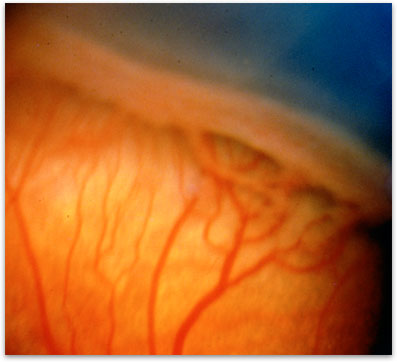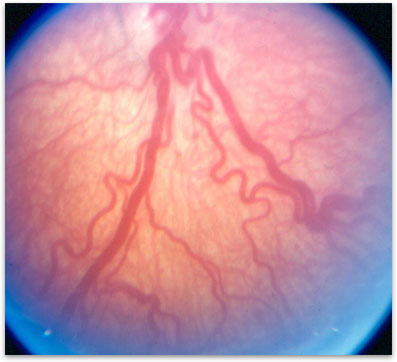Retinopathy of Prematurity
What is Retinopathy of Prematurity?
Retinopathy of Prematurity (ROP) occurs in some premature infants when abnormal blood vessels grow in the retina. The retina is a specialized layer of neural tissue that coats the back of the eye and is responsible for helping you to see. When many premature infants are born the retina has not yet fully developed. As the retina grows in the premature infant, sometimes abnormal blood vessels develop instead of normal ones. These abnormal blood vessels can lead to bleeding and blindness if not treated.
What causes Retinopathy of Prematurity?
It is unclear exactly why some premature infants get ROP. In a normal full term infant the retinal blood vessels are fully developed in the last few weeks before birth. When an infant is born premature, the blood vessels in the retina have not had a chance to finish growing. The premature infants retinas have to develop outside of the protective uterus. Premature infants have many exposures not normally experienced by a developing fetus including exposure to medication, high levels of oxygen, temperature changes and light. It is likely these factors interfere with the normal development of the retinal blood vessels leading to ROP.
Do all premature infants develop ROP?
The vast majority of premature infants do not develop ROP. Even if an infant develops ROP 90% of the time it is only mild and resolves without the need for any treatment. Infants that are born with a weight of 1250 grams or less or those who are born before 31 weeks gestation are at highest risk.
How is Retinopathy of Prematurity diagnosed?
The diagnosis of ROP is made by dilating the pupils and conducting a thorough examination of the retina. Only infants that are at risk of developing ROP need to have their eyes examined. Infants less than 1500 grams (3.3 lbs) and/or with a gestational age less than 31 weeks need to have their eyes monitored. Typically the first examination is about 4-6 weeks after birth. If any ROP is found then the eyes need to be monitored more closely.
What are the stages of ROP? There are 5 Stages:
Stage I — Mild abnormal blood vessel growth. Most children who develop stage I ROP improve spontaneously without the need for any treatment.
Stage II — Moderate abnormal blood vessel growth. Most children who develop stage II ROP improve spontaneously without the need for any treatment.
Stage III — Severe abnormal blood vessel growth (figure 1). The abnormal blood vessels grow toward the center of the eye instead of following their normal growth pattern along the surface of the retina. Some infants who develop stage III improve with no treatment and eventually develop normal vision. However, when infants have a certain degree of Stage III and "plus disease" develops, treatment is considered. "Plus disease" means that the blood vessels of the retina have become enlarged and twisted, indicating a worsening of the disease (figure 2). Treatment at this point has a good chance of stopping the disease from getting worse.
Stage IV — Partially detached retina. The abnormal blood vessels bleed and cause scarring. This scarring begins to pull the retina away from the wall of the eye. Surgery is usually needed.
Stage V — Completely detached retina. This stage is very difficult to treat. Even with surgery most eyes have very little if any vision.
How is ROP treated?
Early stages of ROP usually improve spontaneously without the need for any treatment. Once extensive stage III ROP and ‘Plus’ disease develop, laser treatment is usually recommended to stop the disease from getting worse. The laser surgery is usually done in the neonatal intensive care unit (NICU) under close monitoring by the NICU staff. The laser is used to treat the undeveloped retina. In most cases, the laser causes the abnormal blood vessels to shrink up and go away. If stage IV or V ROP develops, surgery is usually needed.
What is the long-term impact of Retinopathy of Prematurity?
Mild ROP usually causes no long-term vision problems. More advanced forms of the disease, especially stage IV and V ROP can lead to significant vision loss or blindness. Since prematurity can cause many different eye problems, all premature children and children with ROP need to be followed closely. Prematurity can cause amblyopia (lazy eye), eye misalignment (strabismus), myopia (nearsightedness), and vision loss.

Figure 1. Advanced ROP, stage III, showing abnormal blood vessel growth. Treatment is often needed

Figure 2. Plus disease showing the enlarged and twisted blood vessels

